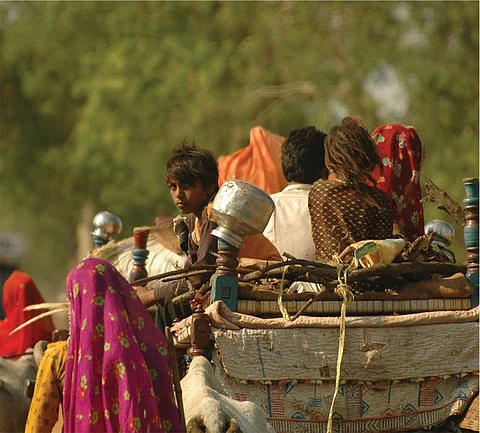

Extreme weather events have played a major role in mass migration in two districts in India. These events, coupled with a lack of social protection measures, forced the villagers in Odisha’s Kendrapara district and Jharkhand’s Palamu district into distress migration, according to a new study.
Rapid-onset events, like floods, increased the odds of migrating by 687 per cent. At the same time, slow-onset events, like drought, increased the likelihood by 172 per cent, noted the study by the International Institute for Environment and Development (IIED), a non-profit.
Researchers analysed the impact of losses and damages due to extreme climate events in these locations and examined how it forced the villagers into distress migration. They interviewed people from 14 villages in these two contrasting geographies.
Some 60 per cent of the respondents in Kendrapara said rapid-onset events are a major climate stressor. At the same time, 87 per cent in Palamu stated that slow-onset events were the reasons for the same.
Migration is sometimes the only option for survival during a rapid-onset event. Such events cause widespread damage to crops, lands and property — snatching away options for in-situ adaptation
In slow-onset events, the situation is slightly different. People migrate during a drought for better socio-economic conditions as their livelihoods are natural-resource based — either farming, livestock rearing, or fishing.
The table reflects the number of losses the villagers suffered in 2021-2022 due to climate change. Kendrapara, with rapid onset events, suffered more losses compared to Palamu. The latter suffered fewer losses due to droughts. Source: IIED.
The availability of MGNREGA job cards decreased the chances of migration. Only 33 per cent of the villagers in Kendrapara possessed the card, while 42 per cent in Palamu had it.
“Availability of a job card under the public works programme reduced the odds of migrating in both rapid-onset (by 66 per cent) and slow-onset (by 59 per cent) contexts,” the researchers said.
The issue of job cards is more pronounced in Kendrapara, IIED’s Principal Researcher of climate change Ritu Bharadwaj told Down To Earth. Some of the villagers surveyed are migrants from Satbhaiya (a group of seven villages) that went under water due to sea-level rise.
These villagers resettled in Bagapatia in Kendrapara. They could not get MGNREGA cards as the Panchayats didn’t recognise them, Bharadwaj added.
“In Palamu, its remote location and a dire amount of corruption prevented villagers from getting the MGNREGA cards that guarantee 100 days of employment,” said Bharadwaj.
But those who had access to job cards said they preferred not to migrate out in distress during a climate crisis, Bharadwaj added.
"The average wage of some of the women who worked in brick kilns in Palamu was around Rs 200 a day. Under the MGNREGA scheme, they will be paid Rs 225,” Bharadwaj said.
The villagers were not covered under the public distribution system (PDS), which guarantees subsidised food grain to the poor.
Only 0.47 per cent of the surveyed households in Palamu had access to the PDS system. And 43 per cent of respondents said they often have only one meal per day.
Food shortage increased the odds of migrating by 71 per cent, according to the report. “Variations in precipitation, increased drought and extended frost conditions led to food scarcity,” it read.
Social factors like caste also played an important role in driving migration. Belonging to a scheduled caste or scheduled tribe community increased the odds of migrating by 338 per cent.
Some 98 per cent of the survey’s respondents were from marginalised communities in Palamu. Respondents told the researchers that they prefer not to work under feudal landlords — a system that still prevails in Palamu. They chose to migrate and face the difficulties instead.
“But even in destination sites, they are exploited. They often migrate with low bargaining power. This, in turn, results in trafficking or being trapped in a slavery-like situation,” Bharadwaj said.
The percentage of victims of trafficking was more in Palamu (42 per cent) than in Kendrapara (16 per cent), according to another study.
“Migration was facilitated by intermediaries, without any formal registration. Aspiring migrants have low bargaining power for wage negotiations or any other benefits,” the researchers found.
These labourers are often employed in hazardous environments. But those workers with skill certificates have more bargaining power.
“We propose that MGNREGA conduct more skill training and find a way to ensure it is displayed. This can be done by making provisions to display qualifications on Aadhar cards, which most of the migrants had,” said Bharadwaj.
More than anything, they should be provided adequate protection under labour laws and policies. These should ensure job security, health and accident insurance, decent working conditions and basic minimum worksite facilities, Bharadwaj added.